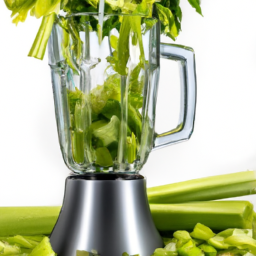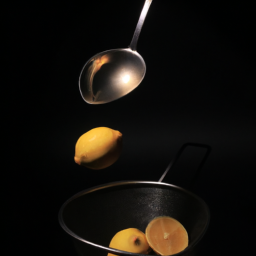I used to think it was impossible to make green juice without using a juicer. After all, how could you blend different vegetables and fruits into a smooth liquid without the help of a fancy machine?
But then I realized that you don’t actually need a juicer to make delicious, nutritious green juice. All you need is a blender, a few key ingredients, and a little bit of know-how.
Making green juice without a juicer is like baking a cake without an oven. Sure, it might seem like an essential tool for the task, but with a little creativity and resourcefulness, you can still achieve delicious results.
Plus, making green juice at home is a great way to save money, reduce waste, and customize your blend to your personal taste preferences.
In this article, I’ll walk you through the steps of making green juice without a juicer, so you can enjoy all of the health benefits of this popular beverage without breaking the bank.
Key Takeaways
- Making green juice without a juicer is possible with a blender and a few key ingredients.
- Frozen or canned fruits and vegetables can be used as alternatives to fresh produce.
- Ingredients should be washed and chopped into small pieces.
- Experiment with different ingredient combinations to enhance flavor.
Gather Your Ingredients
Now that I’m ready to make my own green juice without a juicer, I need to gather my ingredients. While a juicer makes the process easier, it’s still possible to make green juice without one.
The first thing I need to consider is ingredient alternatives. If I don’t have access to fresh fruits and vegetables, I can still make green juice using frozen or canned options. These can be just as healthy as fresh produce, as long as they are not loaded with added sugars or preservatives.
Some great frozen options include spinach, kale, and berries. Canned options like peas and beets are also great additions to green juice. Incorporating these ingredient alternatives can help me get all the health benefits of green juice without breaking the bank or relying solely on fresh produce.
Now, it’s time to prepare my ingredients.
Prepare Your Ingredients
Before I start preparing my ingredients for green juice, I always make sure to wash my greens thoroughly. Then, I chop them into small pieces that fit easily into my blender.
For my fruits and vegetables, I peel them and chop them into smaller pieces to help my blender puree them better. By taking these steps, I ensure that my green juice is filled with fresh, nutrient-rich ingredients.
Wash and Chop Your Greens
First things first, grab a sharp knife and chop your leafy greens into small pieces, making sure to remove any tough stems. Not only are raw greens an excellent source of vitamins and minerals, but they also contain enzymes that aid in digestion and boost your overall health.
To properly wash and dry your greens, fill a large bowl with cold water and submerge your chopped greens, gently swishing them around to remove any dirt or debris. Then, transfer them to a salad spinner or use a clean kitchen towel to pat them dry.
Once your greens are washed and dried, it’s time to move on to the next step and peel and chop your fruits and vegetables. By incorporating a variety of colorful produce, you’ll not only add flavor and sweetness to your green juice, but you’ll also provide your body with a range of nutrients.
Peel and Chop Your Fruits and Vegetables
Get ready to add some delicious and nutritious fruits and veggies to your chopped greens by peeling and chopping them into bite-sized pieces. Peeling your fruits has a few benefits. It can remove any residue or pesticides that may be on the skin, and it can also improve the texture and taste of your juice.
Some fruits, like oranges and grapefruits, can be peeled by hand. Others, like pineapple and kiwi, may require a peeler or knife. When it comes to chopping your vegetables, it’s important to keep in mind the size of your blender. Chopping your produce into smaller pieces can make it easier for your blender to process and can result in a smoother juice.
Here are a few tips for chopping your vegetables:
- Use a sharp knife to avoid crushing or bruising your produce.
- Cut your vegetables into evenly sized pieces to ensure they blend evenly.
- If you’re using tougher vegetables like carrots or beets, consider steaming them first to soften them up.
Now that you’ve got your produce washed, chopped, and peeled, it’s time to choose your blender.
Choose Your Blender
To select the perfect blender for your green juice, you’ll want to make sure it has at least 1000 watts of power, so your drink will be smooth and creamy. Blender types range from personal-sized blenders to high-powered professional blenders. Personal-sized blenders are a great budget option and take up less space on your kitchen counter, but they may not have the power needed to blend tougher fruits and vegetables. Professional blenders, on the other hand, have more power and can handle larger quantities of ingredients, but they can be expensive and take up more space.
Here’s a table to help you choose the best blender for your green juice:
| Blender Type | Power | Price Range | Suitable For |
|---|---|---|---|
| Personal Blender | 300-600 watts | $20-$100 | Soft Fruits and Vegetables |
| Countertop Blender | 1000-1500 watts | $50-$300 | Tough Fruits and Vegetables |
| High-Powered Blender | 1500-2000 watts | $300-$500+ | Large Quantities and Tough Ingredients |
Now that you’ve chosen the perfect blender for your green juice, it’s time to blend your ingredients.
Blend Your Ingredients
Now that you’ve got your blender, let’s start blending your ingredients into a delicious and nutritious green juice. When it comes to blending techniques, it’s important to add your ingredients in stages.
Begin with the leafy greens, such as spinach or kale, followed by the softer fruits and vegetables like cucumber or avocado. Finally, add any frozen fruits or ice cubes to give your juice a refreshing texture.
To enhance the flavor of your green juice, experiment with different combinations of ingredients. For example, adding ginger or lemon can give your juice a zesty kick, while adding pineapple or apple can make it sweeter. Don’t be afraid to mix and match until you find the perfect combination for your taste buds.
Now that your ingredients have been blended, it’s time to strain your juice. This will remove any pulp or chunks, leaving you with a smooth and refreshing juice.
Strain Your Juice
Once your ingredients have been blended, it’s time to strain the juice to achieve a smooth and refreshing texture, ensuring that there are no pulp or chunks left behind. Straining your juice also helps to remove any excess fiber, making it easier for your body to absorb the nutrients.
The benefits of straining your juice include a smoother texture, better taste, and easier digestion. There are different types of strainers available for making green juice without a juicer, such as a fine-mesh strainer or cheesecloth.
A fine-mesh strainer is ideal for removing large chunks of pulp, while cheesecloth is perfect for removing small particles and extracting as much juice as possible. Simply place the strainer over a bowl and pour the blended juice through it, using a spoon or spatula to press the juice through the strainer.
Once you’ve strained the juice, you can add optional extras to enhance the flavor, such as ginger, lemon, or honey.
Add Optional Extras
Enhance the flavor of your freshly strained juice with some optional extras like ginger, lemon, or honey! Not only do these ingredients add a delicious taste to your juice, but they also come with added health benefits.
Here are some tips on how to choose the right optional extras for your green juice:
- Ginger: known for its anti-inflammatory properties, ginger can help reduce muscle soreness and joint pain. It also aids in digestion and can help alleviate nausea.
- Lemon: rich in vitamin C, lemon can help boost your immune system and promote healthy skin. It also has detoxifying properties and can aid in digestion.
- Honey: a natural sweetener, honey can help regulate blood sugar levels and has antibacterial properties. It also contains antioxidants that can help reduce the risk of chronic diseases.
- Mint: refreshing and cooling, mint can help soothe an upset stomach and aid in digestion. It also has antioxidant properties that can help protect against cell damage.
- Cucumber: high in water content, cucumber can help keep you hydrated and promote healthy skin. It’s also rich in vitamins and minerals that can help regulate blood pressure.
By adding these optional extras to your green juice, you not only enhance the taste but also reap added health benefits. Once you’ve chosen your preferred ingredients, mix them in with your strained juice and give it a good stir.
Now that your green juice is complete, it’s time to store it properly to ensure it stays fresh and nutritious.
Store Your Juice
Now that I’ve made my green juice without a juicer and added any optional extras, it’s time to store it properly.
To keep the nutrients and freshness intact, I always use an airtight container. Then, I either refrigerate it for up to three days or freeze it for longer storage.
Use an Airtight Container
To keep your green juice fresh and flavorful, all you need is an airtight container. Airtight containers are important for preserving the nutrients and flavors in your juice and preventing oxidation. They also prevent spills and leaks, making it easier to transport your juice on the go.
When choosing an airtight container for your green juice, look for one that’s made of durable, non-toxic materials like glass or stainless steel. Plastic containers can contain harmful chemicals that can leach into your drink over time. Additionally, opt for a container with a tight-fitting lid to prevent air from entering and spoiling your juice.
To maintain the freshness of your green juice, it’s important to either refrigerate or freeze it as soon as possible.
In the next section, we’ll discuss how to properly store and preserve your green juice for later consumption.
Refrigerate or Freeze
If you want your green juice to last longer and retain its nutrients, the best thing you can do is refrigerate or freeze it as soon as possible. Refrigeration slows down the oxidation process, which helps to preserve the nutrients in the juice. Moreover, refrigerating the green juice can also help to prevent the growth of harmful bacteria, which can cause the juice to spoil quickly.
Here are some benefits of refrigerating green juice and freezing it for future use:
-
Refrigerating green juice can help to extend its shelf life by up to 72 hours.
-
Freezing green juice can preserve its nutrients for up to three months.
-
Frozen green juice can be thawed in the refrigerator or at room temperature, and it should be consumed within 24 hours of thawing.
Now that you know how to store your green juice properly, it’s time to learn how to clean your blender.
Clean Your Blender
Before you begin blending your green juice ingredients, make sure to give your blender a thorough cleaning by wiping down the blades and base with a damp cloth and mild soap. Effective cleaning of your blender is crucial to prevent the buildup of bacteria and mold, especially if you plan to use your blender regularly for making green juice.
One common mistake people make is not cleaning their blender immediately after use, which can lead to stubborn stains and odors that are difficult to remove. Apart from health concerns, keeping your blender clean also benefits the taste and quality of your green juice. A dirty blender can leave behind residue and flavors from previous blends, affecting the taste of your current mixture.
Additionally, a clean blender can prevent any unwanted chunks or fibers in your juice, resulting in a smoother and more enjoyable drinking experience. So, take the time to clean your blender properly before each use and experience the benefits of a fresh and flavorful green juice.
Now, let’s move on to the next step and experiment with different combinations of green juice ingredients.
Experiment with Different Combinations
You must try experimenting with different combinations of ingredients to take your green juice game to the next level. Flavor combinations can make all the difference when it comes to enjoying your homemade green juice. Don’t be afraid to mix and match fruits and vegetables to see what works best for your taste buds.
Some popular combinations include spinach, cucumber, and apple, or kale, pineapple, and ginger. Benefits of experimenting with different ingredients go beyond just taste. Different fruits and vegetables offer a variety of health benefits. For example, adding ginger to your green juice can help with digestion and reduce inflammation. Pineapple contains bromelain, which can aid in digestion and reduce inflammation as well.
By experimenting with different combinations, you can create a green juice that not only tastes great but also helps you feel your best. Now that you’ve experimented with different flavor combinations, it’s time to sit back and enjoy your homemade green juice!
Enjoy Your Homemade Green Juice!
Now that you’ve experimented with different combinations of fruits and vegetables, it’s time to enjoy your homemade green juice! There are many benefits to drinking green juice, such as providing a boost of nutrients, aiding digestion, and promoting overall health. Plus, making your own juice allows you to control the ingredients and avoid added sugars or preservatives found in store-bought options.
To make incorporating green juice into your daily routine easier, try these tips:
- Start with a small amount, such as a shot or half a cup, and gradually increase as your body adjusts.
- Drink your juice in the morning on an empty stomach for optimal absorption of nutrients.
- Mix it up with different fruits and vegetables to prevent boredom and maximize nutritional benefits.
- Store your juice in an airtight container in the fridge for up to 24 hours to maintain freshness.
- Don’t be afraid to experiment and find what works best for you and your taste preferences.
By following these tips and enjoying your homemade green juice, you can reap the many benefits of this nutrient-packed beverage. So grab a glass and cheers to your health!
| Benefits of Drinking Green Juice | Tips for Incorporating Green Juice into Your Daily Routine | ||
|---|---|---|---|
| Provides a boost of nutrients | Start with a small amount and gradually increase | ||
| Aids digestion | Drink on an empty stomach in the morning | ||
| Promotes overall health | Mix it up with different fruits and vegetables | ||
| Allows control of ingredients | Store in an airtight container in the fridge | ||
| Avoids added sugars or preservatives | Experiment and find what works best for you | and enjoy the benefits of a delicious and nutritious morning smoothie every day! |
Frequently Asked Questions
Can I use frozen fruits and vegetables in my green juice?
Frozen fruits and vegetables can be used in green juice, but fresh produce is typically better. To properly thaw frozen produce, place it in the fridge overnight. Avoid microwaving or leaving it at room temperature.
How long can I store my green juice in the refrigerator?
Storing green juice is like preserving a delicate flower. To maximize nutrients, select fresh ingredients and prepare them properly. Best practices for freshness and taste include refrigerating immediately, using airtight containers, and consuming within 48 hours to prevent spoilage.
Can I use a food processor instead of a blender to make green juice?
A food processor can be used instead of a blender for green juice, but the result may be less smooth. Pros of using a food processor include easier cleanup and lower cost. Protein powder can be added to green juice for added nutrition.
What’s the best way to clean my blender after making green juice?
To clean my blender after making green juice, I immediately rinse it with warm water and dish soap. Then, I fill it with water and blend again to remove any leftover pulp. Finally, I give it a thorough scrub and let it dry. Blender cleaning tips include avoiding leaving pulp in the blender and using a brush or sponge to clean hard-to-reach areas.
Do I need to peel my fruits and vegetables before adding them to my green juice?
Peeling fruits and vegetables before juicing is a personal preference. However, the peels contain important nutrients and fiber, so leaving them on can increase the nutritional value of your juice. Various juice extraction methods can handle peels differently.
Conclusion
All in all, making green juice without a juicer is a simple and rewarding process. It’s a great way to incorporate more fruits and vegetables into your diet and to boost your overall health and well-being. Plus, it’s a fun and creative way to experiment with different flavors and combinations.
So next time you’re in the mood for a refreshing and nutritious drink, don’t hesitate to try making your own green juice at home. With a few easy steps and the right tools, you can enjoy the benefits of fresh, homemade juice anytime you want. And who knows, you may even discover a new favorite recipe that becomes a staple in your daily routine.
So go ahead, grab your blender and get juicing!
In conclusion, as Ferris Bueller once said, "Life moves pretty fast. If you don’t stop and look around once in a while, you could miss it."Don’t let the fast pace of modern life prevent you from taking care of yourself and enjoying the simple pleasures of homemade green juice. With a little effort and creativity, you can make a positive impact on your health and your taste buds.
So go ahead, give it a try and see how much better you feel!
Ilana has been a vegan for over 10 years. She originally made the switch for health reasons, but soon found herself becoming more and more passionate about the ethical and environmental implications of a vegan lifestyle. Ilana is the author of The Graceful Kitchen, a blog all about veganism. She loves to cook up delicious and nutritious vegan meals, and share her recipes with others who are interested in leading a cruelty-free life. Ilana is also a strong advocate for using whole foods as the foundation of a healthy diet, and believes that going vegan is one of the best ways to achieve this.










